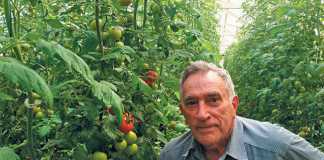
Storing and cooling plums at the correct temperature can make all the difference between a juicy, delectable fruit or a spoiled one. Once the fruit has been harvested, it must be stored at a temperature of -0,5°C for three weeks or more. This is done so that plums can reach supermarket shelves across the world fresh, or stay fresh for the local market. Unfortunately, during the cold-storage period, fruit can spoil.
While it is better to cool plums as fast as possible after harvest, I found in a recent study that the cooling has to be done stepwise to -0,5°C to prevent internal browning of the fruit. Internal browning or chilling injury can also be curbed by warming plums for a few days at 7,5°C in the middle of the storage period. Most plum varieties develop higher levels of internal browning when they are cooled fast directly after harvest.
It is unwise to store plums at slightly higher temperatures for the entire storage period, because the fruit will be overly soft and prone to rot. This will mean losses for supermarkets, and for consumers who may expect some shelf life from the fruit.
Plums harvested during a cooler part of the season (November and December) are more prone to internal browning than varieties harvested during the warmer months of summer (January to March).

Left to right: Plums with internal browning. Plums going through a gel breakdown.
Early season cultivars contain higher concentrations of polyunsaturated fatty acids – which are good for the heart – than late season cultivars. Unfortunately, these fatty acids are prone to damage by free radicals produced in fruit stored at low temperatures, which leads to internal browning. There are a number of factors that aggravate or alleviate browning.
When plums are harvested less mature, their membranes are more ‘fluid’ at low storage temperatures and the fruit is less prone to browning. The membranes are more fluid because they have lower concentrations of saturated fatty acids than more mature fruit. Saturated fatty acids harden the membranes during cold storage, while mono- and poly-unsaturated fatty acids stay fluid at low temperatures.
This can be compared to butter, which contains high concentrations of saturated fatty acids, hardening in the fridge, while olive oil, which has high concentrations of mono- and polyunsaturated fatty acids, remains fluid. Less mature plums also have higher levels of antioxidants to protect them against free radicals when stored at low temperatures. These plums are, therefore, less prone to developing internal browning when stored for long periods at low temperatures.
For optimal eating quality in plums, producers should harvest plums, especially the early season varieties, a little less mature, and cold rooms should consider cooling plums stepwise. Supermarkets and exporters will give consumers a better quality eating plum if they store the fruit with an intermittent warming period. By being able to understand why chilling injury happens to plums, it is possible to take steps to prevent its occurrence.
Dr Mariana Jooste is a researcher in the Department of Horticultural Science at Stellenbosch University. This article is based on her recent doctorate in horticultural science. Phone Martin Viljoen, Stellenbosch University, on 021 808 4921 or 082 752 396 or email [email protected]













